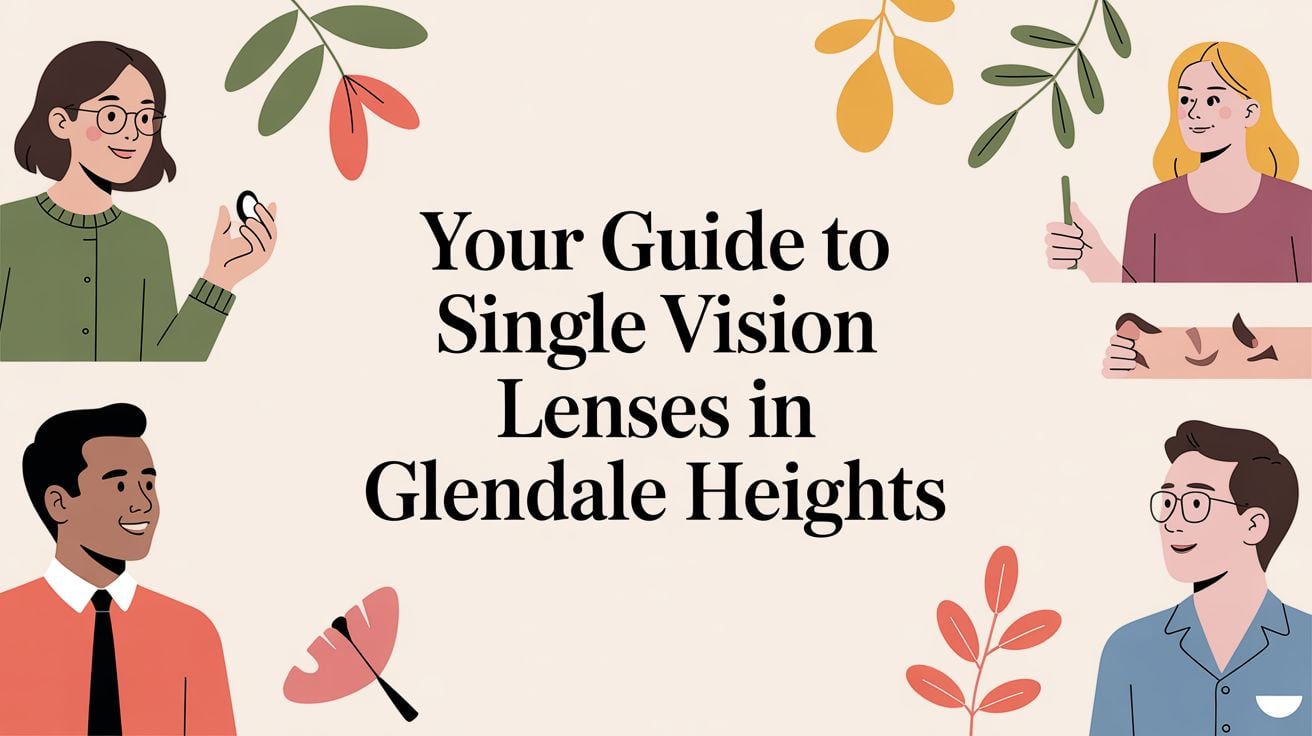Ever looked at your glasses prescription and felt like you were trying to crack a secret code? You're definitely not alone. The simple truth is that all those numbers and letters are a highly specific blueprint for crafting your perfect vision. For residents in and around Glendale Heights, understanding what sphere (SPH), cylinder (CYL), and axis actually mean is the first step to becoming an active partner in your own eye health.
Your Guide to Reading an Eye Prescription
Those mysterious numbers on your prescription are the key to turning a blurry world into a sharp, vibrant one. Whether you need help seeing street signs clearly on North Avenue or reading a menu at a local Glendale Heights restaurant, this guide will translate every part of your prescription into plain, approachable English.
We're going to break down the confusing terms with simple, real-world analogies. Think of it as turning a complex formula into information you can actually use. Once you grasp these fundamentals, you'll see exactly why our detailed eye exams in Glendale Heights are so crucial for perfect sight.
Why Does My Prescription Matter, Anyway?
Your prescription is so much more than a piece of paper—it's a personalized map detailing your unique visual needs. It's the final, vital result of your eye exam that allows an optician to create lenses that are made just for you. Getting a handle on these details helps you in a few important ways:
- Make Smarter Choices: When you know what each number means, you can choose the right type of lenses for your lifestyle with confidence.
- Talk to Your Doctor: You’ll be able to have much clearer conversations with your eye doctor when you understand the language of your own vision correction.
- Track Changes Over Time: Noticing how your numbers shift from year to year is a great way to stay on top of your eye health as it evolves.
At its core, your prescription is the communication tool between your optometrist and the lab that makes your glasses. Getting it right is everything.
The Universal Language of Vision
To make sure your prescription can be understood anywhere, optometrists use a standardized format. Your prescription will almost always include three main components: sphere (SPH), cylinder (CYL), and axis. Each of these numbers plays a specific role in correcting your vision.
The sphere value, for instance, tells you if you're nearsighted (a minus sign) or farsighted (a plus sign). This is measured in units called diopters (D), which represent the amount of focusing power needed to bring your vision back into focus.
This universal system ensures that a prescription from an optometrist in Glendale Heights can be filled accurately anywhere in the world. The process of finding these exact numbers is called a refraction test, and it’s a fundamental part of every comprehensive eye exam.
To help you get familiar with the shorthand, here’s a quick rundown of the abbreviations you’ll see on your prescription form.
Quick Guide to Prescription Abbreviations
This table breaks down the common abbreviations you'll find on your eye prescription and what each one represents.
| Abbreviation | What It Means | Example Value |
|---|---|---|
| OD | Oculus Dexter, Latin for "right eye" | N/A |
| OS | Oculus Sinister, Latin for "left eye" | N/A |
| OU | Oculus Uterque, Latin for "both eyes" | N/A |
| SPH | Sphere: The main lens power for your eye | -2.75 |
| CYL | Cylinder: Power to correct astigmatism | -1.50 |
| Axis | The orientation of the cylinder correction | 180 |
| ADD | Add Power: Extra power for reading glasses | +2.00 |
| Prism | Power to correct eye alignment issues | 0.5 BO |
| PD | Pupillary Distance: The space between your pupils | 63 |
Think of this table as your personal decoder ring for your vision! Now, let's dive into what each of these terms actually means for your eyes.
Decoding SPH, CYL, and Axis Numbers
Now that we've got the basics down, let's get into the heart of your prescription: the three numbers that do all the heavy lifting. I’m talking about Sphere (SPH), Cylinder (CYL), and Axis. Once you understand how these three work together, you'll see just how much precision goes into correcting your vision. Think of them as the specific coordinates that map out exactly what your eyes need.
Each of these values has a very distinct job. When they're combined, they give the lab a precise blueprint for crafting lenses that will give you that crystal-clear sight you're after.
Sphere: The Foundation of Your Vision
The Sphere (SPH) number is the main event. This is the primary power of your lens, correcting for either nearsightedness or farsightedness. It's measured in units called diopters (D) and is usually the first number you'll spot on your prescription for each eye.
If you see a minus sign (-) in front of the SPH value, it means you're nearsighted (the clinical term is myopia). This is why things in the distance—like street signs or the TV across the room—look blurry. The bigger the number after the minus sign, the more correction you need. For example, a -4.50 is a much stronger prescription than a -1.50.
On the flip side, a plus sign (+) means you're farsighted (hyperopia), which makes objects up close appear blurry. Just like with nearsightedness, a higher number like +3.75 indicates a stronger prescription than +1.25. And if you happen to see "PL" or "Plano," that’s great news—it just means you have zero correction needed in that eye.
Correcting Astigmatism with Cylinder and Axis
While Sphere handles the basic focusing power, many people have a common condition called astigmatism, which needs a bit more finessing. This is where the Cylinder and Axis numbers come into play. Astigmatism simply means the front surface of your eye (the cornea) is shaped more like a football than a perfectly round basketball.
This irregular curve causes light to focus unevenly, leading to blurry or distorted vision at pretty much all distances. It's incredibly common, affecting about one in three people. To fix this, your prescription needs more than just Sphere power.
The infographic below shows how these values appear on a typical prescription.
As you can see, the CYL number indicates the amount of astigmatism, while the Axis pinpoints its location for a truly custom correction.
Key Insight: Cylinder and Axis are a team. One number is useless without the other. Together, they provide a complete picture of your astigmatism, ensuring your lenses are crafted to perfectly counteract the unique curvature of your eye.
Let’s break down what each one does:
- Cylinder (CYL): This measures the severity of your astigmatism. Just like Sphere, it’s measured in diopters and will have a minus or plus sign. If this box is empty on your prescription, you have no significant astigmatism to worry about.
- Axis: This number shows the orientation of the astigmatism, almost like a point on a compass. It’s always a number between 1 and 180 degrees, and it tells the lab exactly where on the lens to place that cylindrical power.
So, a prescription might look something like this: SPH -2.00 / CYL -1.50 / Axis 180.
This tells the optician that the lens needs -2.00 diopters of spherical power for nearsightedness, plus an additional -1.50 diopters of cylinder power placed at the 180-degree axis to correct the astigmatism. Once we have these numbers, finding the perfect solution, like specialized contact lenses for astigmatism, becomes straightforward.
These three values—Sphere, Cylinder, and Axis—truly form the core of your visual fingerprint. During an eye exam, we take great care to measure these numbers with precision, ensuring the prescription we provide is perfectly tuned just for you.
ADD Power and Prism: The Finishing Touches on Your Prescription
Sometimes, a prescription needs a little something extra beyond the basics of sphere, cylinder, and axis. If your vision challenges are a bit more complex, you might see two other values pop up: ADD Power and Prism Correction.
Not everyone has these numbers on their prescription. But for those who do, they're the key to making vision feel truly effortless and comfortable. Let’s break down what they mean in simple terms.
What Is ADD Power?
Ever find yourself holding a book at arm's length just to get the words in focus? That’s a classic sign of presbyopia, a completely normal part of aging where our eyes lose some of their ability to focus up close. The ADD value is your eye doctor's answer to this exact problem.
Short for "addition," the ADD power is the extra magnifying strength added to the lower part of your lenses. It’s always a positive number (you'll see it written like +1.75 or +2.25) and is usually the same for both eyes.
Think of it as a built-in magnifying glass for your reading zone. Your main prescription takes care of seeing things far away, while the ADD power provides a dedicated boost for your phone, a menu, or a good book. This is the magic behind bifocals and modern progressive lenses.
The bottom line: ADD power is what gives you back that sharp, close-up vision. It’s the extra strength in multifocal lenses that combats the focusing issues caused by presbyopia, which typically affects adults over 40.
If you have an ADD value, you'll need a multifocal lens. Wondering what your best option is? We can walk you through it, and you can also learn more by reading our guide on the pros and cons of progressive lenses versus bifocals.
Understanding Prism Correction
While ADD power is fairly common, Prism correction is more specialized—but for the right person, it can be an absolute game-changer. You’ll find this on a prescription when your eyes aren't quite working together as a perfect team. This misalignment can lead to double vision (diplopia), eye strain, and even headaches.
Even a tiny misalignment can make your eye muscles work overtime trying to fuse two separate images into one clear picture. That constant strain is exhausting, often causing headaches and fatigue that you might not even realize are tied to your vision.
So, how does a prism fix this? It's essentially a transparent wedge built right into your lens that bends light before it enters your eye. This redirection tricks your brain into thinking the image is in the right place, allowing your eyes to relax and see a single, clear image without all the effort.
Prism correction has two components:
- Prism Diopters: This number (0.5, 1.0, etc.) tells you the strength of the prism.
- Base Direction: This tells you which way the thickest edge of the wedge is pointing—Base Up (BU), Base Down (BD), Base In (BI), or Base Out (BO).
Prescribing prism requires a careful and precise evaluation of how your eyes work together. It’s one of the reasons we dedicate a full 30 minutes to our high-resolution imaging and detailed eye exams here at iDoctor in Glendale Heights. That extra time allows us to spot these subtle alignment issues and determine if a prism is the solution you’ve been looking for. For anyone suffering from stubborn headaches or double vision, it can bring an incredible sense of relief.
Why Your Glasses and Contact Lens Prescriptions Aren't the Same
It’s one of the most common questions we get at our Glendale Heights boutique: "Can I just use my glasses prescription to order contacts?" The answer is always a firm "no," and for good reason. While both glasses and contacts are designed to help you see clearly, they work from entirely different positions, which means they require completely different measurements.
Think about it this way: your glasses sit a small distance away from your eyes—about 12 millimeters, on average. A contact lens, however, sits directly on the surface of your cornea. That little gap might not seem like a big deal, but it fundamentally changes the physics of how light is bent to correct your vision. The power needed in a lens that's right on your eye is often quite different from the one that sits almost half an inch away.
It All Comes Down to "Vertex Distance"
That gap between your eyeglass lens and your eye has a name: vertex distance. For people with milder prescriptions, the power difference might be pretty small. But once your prescription gets stronger than +/- 4.00 diopters, converting the power for that distance becomes absolutely critical for clear sight.
Your optometrist performs a specific calculation to make this conversion. This ensures the contact lens provides the exact same level of correction on your eye as the eyeglass lens does from a distance. Trying to skip this step is a recipe for blurry vision and a whole lot of eye strain.
Contacts Need More Than Just Power Numbers
The differences don't stop with the prescription power. A contact lens prescription has a whole other set of measurements that you'll never see on your glasses Rx. These numbers are all about making sure the lens fits the unique size and shape of your eye safely and comfortably.
Getting the fit right isn't just about comfort—it's about the health of your eyes. A lens that’s too tight can starve your cornea of oxygen. A lens that’s too loose will slide around, causing irritation and making your vision unstable.
Here are the key measurements you'll only find on a contact lens prescription:
- Base Curve (BC): This number (usually between 8.0 and 10.0) describes the curvature of the back of the contact lens. It's chosen to match the curve of your cornea, so the lens sits smoothly without being too tight or too loose.
- Diameter (DIA): This is simply the width of the lens from edge to edge, measured in millimeters (typically 13.0 to 15.0). It determines how the lens rests on your eye and interacts with your eyelids.
Why Fit Matters: A perfect fit allows the contact lens to move just a tiny bit every time you blink. This subtle movement is crucial because it lets your tears wash underneath the lens, keeping your eyes hydrated, healthy, and feeling great all day.
The Necessity of a Professional Fitting
Because of all these critical differences, the law requires a separate contact lens fitting and evaluation to get a valid prescription. This is far more than just a quick calculation. During a fitting at iDoctor, we take detailed measurements of your cornea's shape and then have you try on actual diagnostic lenses. We then check the fit, watch how the lens moves on your eye, and make sure you're seeing perfectly.
This process guarantees you not only get sharp vision but also a lens that you can wear safely for hours on end. For anyone in the Glendale Heights area looking to try contacts, the journey begins with this personalized evaluation. It's the only way to ensure we're taking the best care of both your vision and your long-term eye health. You can learn more about our prescription contact lenses and what the process involves.
Using Your Prescription with Confidence
Alright, you've cracked the code on your prescription! Now what? The whole point of understanding those numbers and letters isn't just for trivia night—it's about giving you the confidence to be a true partner in your own vision care. Knowing what everything means helps you make smarter choices about your glasses and recognize when it's time to pop back in to see your optometrist.
This isn't just for first-timers, either. Even if you've worn glasses for years, truly getting a handle on your prescription is the first step toward managing your vision health like a pro. It all starts with understanding what your eyes need and why that can shift over time.
When Is It Time for a New Eye Exam?
Your vision doesn't stand still; it evolves as you go through life. That's exactly why prescriptions come with an expiration date, usually good for one to two years. Trying to get by with an old prescription is a recipe for eye strain, headaches, and just plain blurry vision because your glasses are no longer doing the job they were designed for.
You just have to listen to your eyes. They’ll usually give you some subtle (and sometimes not-so-subtle) hints when something is off.
Common Signs You Need a New Exam:
- Frequent Headaches: Are headaches becoming a regular thing, especially after reading or working on the computer? Your eyes could be straining too hard to focus.
- Increased Squinting: Finding yourself squinting to read street signs on Bloomingdale Road or to see the TV clearly? That's your brain's natural way of trying to sharpen a fuzzy image.
- Noticeable Eye Fatigue: If your eyes just feel worn out, sore, or heavy by the end of the day, that's a classic sign of eye strain from the wrong prescription.
- Blurry or Double Vision: This one’s a biggie. Any change in how clearly you see, no matter how small it seems, is a clear signal that it’s time for a check-up.
Catching these signs early saves you from unnecessary discomfort and keeps your vision sharp. We're lucky here in Glendale Heights to have great eye care so accessible, but that's not the reality for everyone. Globally, getting a precise eye prescription is a huge challenge. A 2025 WHO report highlighted that up to 70% of people in some regions who need glasses don't have them, which has a massive impact on their quality of life.
Choosing the Right Frames and Lenses
Your prescription is the blueprint for your perfect pair of glasses. It doesn't just dictate the lens power; it also gives clues about which frames and lens materials will be the most comfortable and look the best.
For example, a strong prescription with high SPH or CYL numbers usually means thicker lenses. If that's you, choosing a smaller frame can make a huge difference in the final lens thickness and weight. Another fantastic option is to go for high-index lenses. This advanced material is specifically designed to be thinner and lighter than standard plastic, making for a much more comfortable and cosmetically pleasing result, especially in a sleek pair of Tom Ford frames.
Another measurement that’s absolutely critical for a perfect fit is your Pupillary Distance (PD). It’s simply the distance between the centers of your pupils, and it ensures the optical sweet spot of your lenses lines up exactly with your eyes. Our team at iDoctor always gets this measurement during your exam, but you can even learn how to measure your pupillary distance at home if you're ordering online.
By pairing your prescription details with the right materials and frames, you can achieve a look that is both stylish and incredibly functional. It’s about creating eyewear that feels like it was made just for you.
So, whether you're searching for a stunning pair of Cartier glasses near me or just need a reliable supply of daily contacts, we're here to help guide you. Our expertise is all about making sure your final choice not only suits your personal style but gives you the crisp, comfortable vision you deserve.
Your Partner for Clear Vision in Glendale Heights
Understanding the numbers on your eye prescription is a huge step toward taking control of your vision. But let's be honest, having a trusted local expert to guide you makes all the difference. Here at iDoctor in Glendale Heights, we believe that empowering you with knowledge is just as crucial as finding you the perfect pair of glasses. Our goal is to give you both.
From the moment you come in for one of our detailed eye exams in Glendale Heights, we make it our mission to ensure you get the most accurate prescription and that you actually understand what it all means. We’ll take the time to walk you through every number, breaking down the optometry jargon into simple, clear language you can feel confident about.
Personalized Care for the Chicagoland Community
We’re proud to be part of the Glendale Heights community, serving our friends and neighbors with the kind of care we’d want for our own families. It doesn't matter if you're a Glenbard North High School student getting your first pair of glasses or a professional looking for a sophisticated set of Tom Ford frames—we tailor the entire experience just for you.
Our boutique is where clinical expertise meets hand-picked style. We welcome patients from all over the Chicagoland suburbs, whether you're just down the street on Bloomingdale Road or visiting from near Camera Park. Your vision is entirely unique, and we think your care should be, too.
Your prescription is more than a set of numbers; it’s the key to seeing your world with absolute clarity. Our role is to be your guide, helping you unlock that potential with expertise and care.
From Confusion to Clarity
Don't let a sheet of confusing numbers stand between you and a world of crisp, vibrant sight. The team at iDoctor is here to answer every question and give you the support you need to feel great about your eye health decisions. We truly see our patients as partners on their vision journey.
Ready to see the difference the best optometrist in Glendale Heights can make? Schedule your appointment today at our Glendale Heights boutique. Let us turn that prescription into perfect vision and help you explore our stunning collection of designer eyeglasses in Glendale Heights, featuring incredible brands like Cartier, Gucci, and Prada. Your clearest vision is waiting.
FAQs About Eye Prescriptions in Glendale Heights
If you're still scratching your head over some of the details, don't worry. Here are answers to a few common questions we hear from our patients right here in Glendale Heights.
Do I need an appointment to look at designer eyeglasses in Glendale Heights?
You are always welcome to stop by our boutique on Bloomingdale Road to browse our curated collection of luxury eyewear from brands like Cartier, Gucci, Tom Ford, and Oliver Peoples. No appointment is needed to look! However, to purchase prescription eyewear, you will need a valid, up-to-date prescription from a qualified eye doctor in Glendale Heights.
How often should I get an eye exam in Glendale Heights?
For most adults, a comprehensive eye exam every one to two years is the sweet spot. This allows us to keep your prescription up-to-date and, just as importantly, screen for underlying health issues before they become serious problems. That said, your eye doctor might recommend more frequent visits. We often suggest yearly check-ups if you have a health condition like diabetes, are over 60, or wear contact lenses in Glendale Heights. And of course, if you ever notice a sudden change in your vision, don't wait for your scheduled appointment—give us a call immediately. Your eye health is too important to put on hold.
Can I use my vision insurance for Cartier glasses near me?
Yes, absolutely! At iDoctor, we believe great vision and great style should go hand-in-hand. That's why we accept all major vision insurance plans. You can use your benefits on our entire collection, including our hand-picked selection of designer eyeglasses. So whether you have your eye on a pair of Gucci, Prada, or classic Ray-Bans, our team is here to walk you through your coverage and help you get the most out of your plan.
Your vision is our priority. Ready to see the world more clearly? Schedule your next eye exam with iDoctor today.






